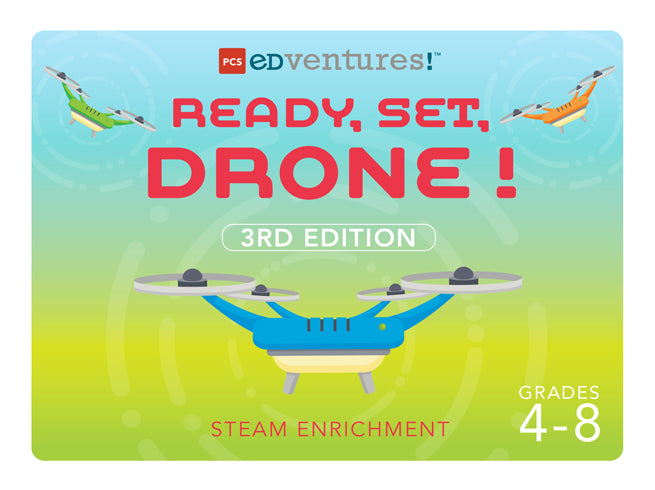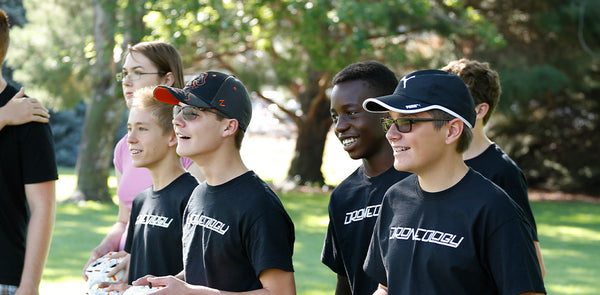
The Mini Drone Revolution
High-speed action. Hairpin turns. Acrobatic maneuvers. Scenic landscapes. Just you, your drone and open airspace. When it comes to flying drones, there’s no more iconic sight than a pilot zooming off into the sunset.
So, why then are pilots heading indoors, leaving the sunshine and fresh air spaces for fluorescence and central heating?
Across the globe, drone enthusiasts and educators are moving inside, focusing their efforts and expertise on smaller, hand-held mini drones. As an alternative to their larger quadcopter cousins, it’s the difference in the size of the drone that educators are getting excited about.
But, Why Are Drone Educators Bringing Their Curriculum Inside?
1. Weather and Space
When it comes to their drone, pilots have their entire system down to a science — because, well, it is science. They’ve tested their flight systems, scoured the market for the latest-and-greatest advancements and racked up countless hours of practice.

Every inch of their quad has been meticulously built and inspected. They know their drone inside and out. That is, until Mother Nature joins in on the fun. Even with the newest technologies installed to keep a drone completely under control, it only takes one rogue gust or rainstorm to send a quad to the repair bench.
That’s one of the reasons why educators are electing to head indoors. With Mother Nature’s influence out of the question, there’s no need to create backup plans or rainy day lessons. Mini drones can be taught year round, which means no longer having to keep your props off all winter long — (here’s looking to you, North Dakota.)
By bringing drones inside, there’s now no need to acquire large, open and undisturbed airspace. Even securing a school’s football field can be difficult with so many events competing for space. For educators, this allows them to utilize what’s already available, allowing them to transform their classrooms and gymnasiums into safe flight zones without the hassle finding the perfect outdoor flight field.
2. Regulation Hurdles
When you fly inside, you avoid a lot of regulatory barriers. From registration fees to FCC compliance, right out of the box, many indoor drones are completely ready-to-fly.

3. Advancements in Technology & Ease of Learning
Mini drones are also bridging the gap between advancing  technologies and elementary education. These drones are more affordable and less intimidating for new pilots to learn to fly on. In the past, mini drones were thought of as cheap toys with a proficiency for breaking. But now, drone manufacturers are starting to put the same tech they use in their top-of-the-line UAVs into their mini’s.
technologies and elementary education. These drones are more affordable and less intimidating for new pilots to learn to fly on. In the past, mini drones were thought of as cheap toys with a proficiency for breaking. But now, drone manufacturers are starting to put the same tech they use in their top-of-the-line UAVs into their mini’s.
The drones in Ready, Set, Drone! Camp are ready-to-fly (RTF) out of the box, utilize simple controls and the flight systems are pre-configured and ready to go — there’s no easier way for an instructor to start a drone program. With minis, safety is a cinch, as prop guards come standard, and with goggles on, the worst-case scenario becomes a bad case of some seriously tangled hair. For the instructor, the simpler kits mean less time on the back-end spent learning and training on the new systems.
With mini drones, students learn to fly on smaller, simpler and more adorable drones.

Drone learning solutions present younger students with the opportunity to explore and fall in love with STEM through an aerial robotics platform. These programs provide a foundation for students to explore more advanced UAV concepts down the road, like lessons in physics, mathematics, coding, engineering and more. With drone experience under their belt, you’re giving students the tools they need to succeed in the Age of Technology.
4. A New Generation of Dronethusiasts
From the physics of flight to the engineering principles of a multirotor vehicle, drones are a STEM gold mine, combining the thrills of high-speed piloting with hands-on learning. This past year, PCS Edventures tapped into this gold mine with the release of its first educational drone package, Discover Drones, a full-sized quadcopter made for high-school students. Focused on training, building, configuring, maintenance and flight of a modular educational drone, the package is the perfect way to get older learners involved in one of the world’s fastest-growing markets. But, this got us thinking.
How can we introduce drones to younger students?
RubiQ, the educational drone included in Discover Drones, is a full-sized quadcopter designed to give high school students an expansive look into the world of drones. So, how could we make drones more accessible for earlier grade levels? By shrinking the drone.
That’s why we created Ready, Set, Drone!

A brand new package developed for 4th-6th grade learners, this set of 12 one-hour lessons is the perfect introduction to the world of unmanned aerial vehicles (UAVs). In this indoor camp, safety is a priority as students learn to fly in first-person view (FPV), exploring the real-world applications of drones by:
- Studying with Droneology, an online drone education platform that introduces students to drone fundamentals, safety and real-world applications
- Mastering basic piloting skills
- Constructing an obstacle course to fly through and a final race to showcase their cumulative knowledge.
Putting critical thinking to the test, the camp also has students brainstorm ways drones could be used for good, sketching out their ideas for new and innovative drones and drone uses. From the safety of classrooms and gymnasiums, Ready, Set, Drone! Is working to transform elementary STEM education.
Mini drones have locked their sights on revolutionizing STEM education, and soon they’ll be zipping around the classrooms of your neighborhood.









2 comments
Hi Lisa! Our support options can be found on https://edventures.com/pages/contact-us, or you can ping us in our site chat or email support@edventures.com. If you have any of the printed curriculum from the last teacher, especially the Digital Resource License Key, that will be helpful for our support team.
I have inherited a set of drones from your program and I need to know what software supports the and their use un the classroom. The teacher who originally put them as part of our curriculum has left. Where can I look for support?